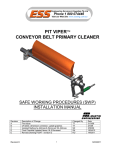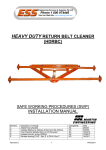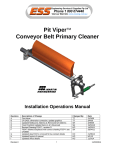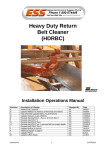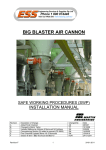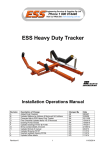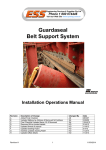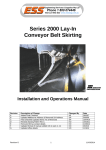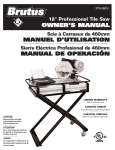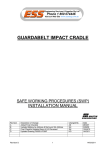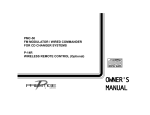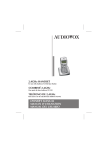Download Trac-Mount Primary Installation Manual
Transcript
Compact Plus Primary Cleaner SAFE WORKING PROCEDURES (SWP) INSTALLATION MANUAL ESS ENGINEERING SERVICES AND SUPPLIES PTY LTD Revision A B C D E Revision E Description of Change Added Final Checklist Update drawings and part numbers EDCR 23 Updated Melbourne Address & Removed SA Address Final Checklist Updated Items 4 & 5 Reversed Updated drawing F0293 Rev F 1 Changed By AS TT SH SH KO Date 28/5/07 28/3/08 3/08/09 15/04/10 14/03/11 14/03/2011 ENGINEERING SERVICES and SUPPLIES OFFICE DETAILS ESS HEAD OFFICE 11-13 TRADERS WAY PO BOX 121 CURRUMBIN QLD 4223 P: (07) 5589 2000 F: (07) 5598 1353 ESS MACKAY 1 PROGRESS STREET PO BOX 5755 MACKAY MC QLD 4740 P: (07) 4952 4600 F: (07) 4952 4717 ESS PERTH 19 CLAVERING ROAD BAYSWATER WA 6053 P: (08) 9370 3155 F: (08) 9272 5130 ESS MAITLAND UNIT 2 BARTON COURT 6 JOHNSON STREET MAITLAND NSW 2320 P: (02) 4932 3544 F: (02) 4932 3611 ESS WOLLONGONG 1/20 DOYLE AVENUE PO BOX 343 UNANDERRA NSW 2526 P: (02) 4272 4422 F: (02) 4272 4434 ESS MELBOURNE 4/314 Governor Road BRAESIDE VIC 3195 P: (03) 9580 0388 F: (03) 9587 5199 ESS EMERALD 11/115 ROBERTS STREET EMERALD QLD 4720 P: (07) 4982 4855 F: (07) 4987 5118 ESS GLADSTONE 2/34 CHAPPLE STREET PO BOX 1475 GLADSTONE QLD 4680 P: (07) 4972 3759 F: (07) 4972 2866 ESS ADELAIDE P: (08) 8262 8955 F:(08) 8262 4944 ESS KALGOORLIE 4/235 HAY STREET PO BOX 10471 KALGOORLIE WA 6430 P: (08) 9021 7991 F: (08) 9021 7291 ESS MOUNT ISA 6 TRADERS WAY PO BOX 1554 MT ISA QLD 4825 P: (07) 4749 4580 F: (07) 4749 3019 CUSTOMER SERVICE NUMBER 1800 074446 TOLL FREE FROM ANYWHERE IN AUSTRALIA Revision E 2 14/03/2011 WARRANTY NOTE ESS WARRANTS the ESS Product to be free of defects both in materials and workmanship for a period of 12 months from the date of despatch of the product from the ESS factory. The warranty given by ESS in this regard will extend only to replacing or repairing product shown to be defective. The warranty also is subject to the following restrictions: (a) Installation of the product contrary to the instructions contained in the supplied manual will void such warranty absolutely; (b) The warranty will not extend to any liability for injuries incurred and which result from the use of the product contrary to the instructions in the manual; (c) Save as prescribed by law, ESS will not be liable for any damage sustained by a purchaser or a third party by way of consequential loss arising out of defects in the product. You are asked to note that ESS offers purchasers a service whereby either: (a) It will install the product and certify the correctness of such installation, or (b) Certify the correctness or otherwise of the installation of the product by third parties. This certification service is designed to ensure that you obtain the full benefit of the ESS warranty hereby provided. If you would like to take advantage of the installation certification service provided, please contact ESS regarding the service. THE CONTENTS OF THIS MANUAL ARE COPYRIGHT TO: ESS ENGINEERING SERVICES AND SUPPLIES PTY LTD ALL RIGHTS RESERVED Information contained herein is for use in the operation of the ESS COMPACT PLUS PRIMARY CLEANER, purchased from ESS and cannot be passed on to any other party without express permission, in writing, from ESS. ESS Despatch Department to complete. Client should retain for warranty. Purchaser / Client: Purchase Order / Contract No.: Site: Conveyor No/s.: Despatch Date: No. Supplied: Description / Part Numbers: Comments: Revision E 3 14/03/2011 INDEX SECTION 1 SAFETY SECTION 2 INTRODUCTION SECTION 3 PREPARATION FOR INSTALLATION SECTION 4 INSTALLATION SECTION 5 OPERATOR TRAINING SECTION 6 ROUTINE MAINTENANCE AND SERVICE SECTION 7 TROUBLE SHOOTING SECTION 8 INSTALLATION & PARTS ASSEMBLY DRAWINGS Revision E 4 14/03/2011 SECTION 1 - SAFETY The Compact Plus Primary Conveyor Belt Cleaner is designed to be quickly and easily serviced by appropriate personnel. If appropriate safe visual access is provided, inspection and tensioning adjustments can be carried out whilst the belt is in operation. However, under no circumstances should servicing or installation of the cleaner be carried out whilst the belt is in operation. The conveyor must be shut down and locked out before any person enters or reaches into the chute or conveyor enclosure. SECTION 2 - INTRODUCTION The Compact Plus is a conveyor belt Primary Cleaner, designed for use on smaller conveyors where space is often restricted. The Compact Plus is suitable for use on conveyor belts that range from 200 to 1200 mm wide, and where belt speed is low to moderate. The patented CARP-2 blade design will provide excellent cleaning performance and long wear life under a range of conditions. Blade materials are available to suit most bulk materials handled. The Compact Plus Primary Cleaner is normally mounted on the face of the conveyor head pulley and is designed to peel off the thick layer of loosely adhering material that often accounts for 80%-90% of carryback. The Compact Plus is normally used in conjunction with at least one secondary cleaner, such as the ESS Compact Secondary, and often with a water spray system. The segmented cleaning blades are of cast Urethane, and can be easily removed by sliding on and off the mainframe track for replacement when worn. Important points to remember concerning the Compact Plus are: 1. The cleaner is directional - it will only clean a belt travelling in the design direction however, the cleaner will not be damaged or affected by belt direction reversal. 2. The cleaner is suitable for use on crowned head pulleys and damaged or grooved belts. The urethane blades quickly conform to the belt profile. 3. For slow moving belts, the cleaner should be positioned lower on the head pulley to ensure the blades are clear of the main material flow. 4. The cleaner requires an access point in the conveyor chute to install and replace the urethane blades. This should be in the form of a covered door of sufficient size to allow a technician to reach in and recover the blades. The access door should comply with all current conveyor and safety regulations. Revision E 5 14/03/2011 SECTION 3 - PREPARATION FOR INSTALLATION 1. CHECK INSTALLATION DRAWINGS - Ensure that you have the correct drawings and equipment for your conveyor(s). 2. PRE-ASSEMBLE THE CLEANER(S) AND MOUNTS - Do this in your workshop or similar free area, rather than at the Conveyor. This will enable you to: verify all required equipment is present familiarise yourself with the cleaner assembly allow you to plan the installation, reducing installation time. 3. ASSEMBLE THE NECESSARY TOOLS & SAFETY EQUIPMENT REQUIRED FOR THE INSTALLATION 4. OBSERVE THE CONVEYOR WHILE RUNNING AND CONVEYING MATERIAL Observe the material trajectory Observe the belt direction - does it reverse or roll back? Observe the belt splice condition Does the belt run true, or track off to one side? Is the Head Pulley out-of-round? Consult ESS if any UNUSUAL conditions are observed in the above. These conditions may result in recommendation of a different installation position or even a different cleaner. Revision E 6 14/03/2011 SECTION 4 - INSTALLATION DANGER Conveyor must be shut down and locked out before any installation or service work is performed. WARNING Thoroughly assess the job and jobsite before proceeding. Ensure that personnel and equipment are protected from injury or damage during installation. ESS recommends that a Job Safety Analysis (JSA) be conducted before proceeding with any installation work. 4.1 INSTALLATION OF COMPACT PLUS MAINFRAME Step 1 - Locate the Centre-line of the Compact Plus Cleaner Mainframe Using the typical installation drawing supplied in this manual, locate the mainframe’s centreline on both sides of the conveyor chute. For conveyors that do not have an enclosed chute, fabricate suitable mounting plates each side of the conveyor, or contact ESS for assistance. Measure radially A mm (see table following) from the face of the belt. From this point draw an arc using the pulley’s centre-line as the centre point. The centre-line of the mainframe can be located anywhere along the radius as long as the blade does not lie in the material’s trajectory. For faster belts, the blade tip should contact the belt near or just below the horizontal centre line of the head pulley. For slower moving belts, lower the cleaner until the tip of the blade clears the material trajectory. Do not place the cleaner lower on the head pulley than necessary, as this will cause the blade to lay flat and allow accumulation of material. Avoid placing the tip of the cleaner above the horizontal centre line of the pulley, as exposure to excessive amounts of material will result in low cleaning performance and high blade wear rates. Ensure that the mainframe is in the same position both sides of the belt – that is, the cleaner is parallel and level to the belt face and head pulley. Revision E 7 14/03/2011 Head Pulley Diameter Offset Dim A 200 60 250 55 300 50 Over 300 45 Step 2 - Verify Mainframe Position Before Proceeding Position the tensioner and mount assembly over the centre-line marks for the mainframe. Verify that the mounts fit, and that adequate room is available to tension the cleaner. If mounts or tensioner interfere with structural members, it may be necessary to locate the cleaner elsewhere on the A mm offset radius, but first remember these points: The mount can be rotated to any angle. The tensioner can be reverse assembled, as long as it is tensioning the blades in the correct direction – see diagram below. The tensioner assembly may be located on the opposite side of the conveyor, as long as access is available for maintenance. Once mounting position is confirmed, proceed. Revision E 8 14/03/2011 Mount and Tensioner assembly can be rotated to any angle and reverse assembled for tensioning in either direction. Step 3 If the cleaner mounts are to be mounted to the chute wall cut a hole Ø70 at the selected mainframe mounting positions each side of the chute. Mark out and drill bolt holes as shown below. If the mount is to be rotated as described above, remember to rotate the bolt hole pattern to the same angle. If the mount is to be attached to structure or brackets other than the chute wall, project the line of the mainframe centre to the mounting position, and provide cutouts and bolt holes at that position. Revision E 9 14/03/2011 Step 4 Remove the blades from the mainframe by first loosening and removing the blade locks. Insert the bare cleaner mainframe through the cutouts in the chute wall. Slide the tensioner side and far side mounts onto the pipe ends of the mainframe and loosely bolt the mounts to the chute walls with the mainframe in the pre-selected position. Do not secure the tensioner lockscrews to the mainframe. Does the centre-line of the mainframe lie A mm from the belt face? (The Compact Plus installation gauge is available to assist in checking this dimension). Is the mainframe level or equal to the pulley shaft? Step 5 Remove the far side mount bush, then slide the mainframe to the far (non tensioner) side until the tensioner end of the mainframe is clear of the inside of the chute. Inside the chute or conveyor enclosure, slide a blade retainer onto the mainframe, followed by the required number of blades, and a second blade retainer. Ensure the blades are facing in the correct direction. Slide the mainframe back through the tensioner side mount, and re-fit the mount bushes. Centre the blades on the mainframe, then tighten the blade retainers in place against either side of the blades. Rotate the mainframe until the blade tips lightly contact the belt. Do the blade tips all touch the belt at the same time? (+1mm)? Revision E 10 14/03/2011 NOTES Slight inconsistencies in the belt thickness and blade shape, accounting for small gaps between blade and belt, will quickly be taken up by blade flexure on tensioning. For crowned head pulleys, ensure that the outside blades on each side are an equal distance from the belt whilst the centre blade is touching. Again, these gaps will quickly close on tensioning. If any questions above have been answered “NO”, take appropriate action to correct the installation. If all questions are answered “YES”, proceed. Step 6 Securely bolt the cleaner mounts and brackets to the chute wall or structure. If not already done, fit and secure the tensioner components in place as shown previously. Ensure that the tensioner is operating in the correct direction. If not, reverse the tensioner assembly to achieve the correct direction. 4.2 SETUP AND ADJUSTMENT OF THE SPRING TENSIONER The Compact Plus Primary Cleaner is supplied with a pair of steel mount plates fitted with low friction bushes. These mounts may be secured to the conveyor chute in any orientation (horizontal, vertical or inclined), to suit site restrictions. Remember, however, that the tensioner assembly also attaches to the mount, and that the tensioner assembly must also clear site restrictions – see previous section. The Compact Plus Spring Tensioner is a simple, robust and reliable tensioning unit. It can be assembled to tension in either the clockwise or anti-clockwise direction and has two mounting positions for each direction. 4.2.1 Assembly of the Spring Tensioner Unit The Compact Plus Spring Tensioner attaches to the cleaner mount by utilising two of the mounting bolts. Ensure that the low friction bush is in place in the mounts before proceeding. Assembly of the tensioner is as follows: Select the tensioning direction required – see diagrams in the installation section. Remove the appropriate mounting bolts from the tensioner side mount, and fit the pivot bracket, again ensuring that the bracket is positioned for the tensioning direction. Bolt the pivot bracket in place. Note: Cast mounts used on later models will have a gusset on one side of the raised hub. This is used on the Far Side mount only, and has no use in the tensioner assembly. Slide the eye end of the adjusting rod over the pin on the pivot bracket and and secure with the split pin. Insert the threaded end of the adjusting rod into the slotted hole of the operating arm, ensuring the the arm is correctly orientated. Slide the operating arm down the Revision E 11 14/03/2011 adjusting rod, then manoeuvre the hub of the operating arm over the end of the mainframe. Fit the spring over the threaded end of the adjusting rod, then fit the washer and adjusting nut, only a few turns. Loosley fit the locking nut. Check that the cleaner and blades are centred to the belt, then rotate the mainframe until the blades are touching the belt. Position the operating arm so that the hub is within 1 - 2 mm of the mount and the tail is extended against the spring. Secure the lockscrews in the operating hub onto the mainframe. By hand, turn the adjusting nut on the Adjusting Rod to bring the cleaner blade tips into light contact with the belt. The tensioner side is now fitted and ready for adjustment. Fit the far side lock collar before proceeding. 4.2.2 Assembly of the Far Side Mount and Lock Collar. The Far Side Lock Collar acts to prevent axial movement of the cleaner mainframe, but with the ESS Compact Plus cleaner, it also doubles as a wear indicator and limiter. Assembly is as follows: Install the Far Side mount as previously described. Slide the Lock Collar onto the Compact Plus mainframe, with the tab pointing inwards toward the mount. With the cleaner blades just touching the belt, as previously described, position the Lock Collar tab at 30° to the mount gusset, in the opposite direction to the tensioning direction. For a clockwise tensioning cleaner, place the tab at 30° to the anticlockwise side of the gusset, and vice versa. Later model cast mounts will have indicator lines at 10°, 20° and 30°. With the tab at 30°, and the Lock Collar approximately 1 - 2 mm clear of the mount, tighten the lockscrews on the Lock Collar to secure the collar to the mainframe. As the cleaner blades wear, the Lock Collar tab will move toward the mount gusset, indicating the blade wear. The blades have approximately 30° of wear rotation, so the tab will contact the gusset, indicating blade replacement is required, and preventing further adjustment or wear of the blades. 4.2.3 Adjustment of the Spring Tensioner The Spring Tensioner is adjusted by simply turning the adjusting nut until the spring is compressed to the length indicated on the table below. Once the correct spring compression is achieved for the belt width, secure the tensioner by tightening the lock nut against the adjusting nut. Revision E 12 14/03/2011 BELT WIDTH (mm) NUMBER OF BLADES SPRING LENGTH (mm) 300 450 600 750 900 1050 1200 1350 2 3 4 5 6 7 8 10 88 84 80 76 72 68 64 56 Installation is complete and the cleaner is ready for service. 4.2.4 Spring Tensioner Assembly and Parts Diagram Revision E 13 14/03/2011 Item Description 1 2 3 4 5 6 7 Mount Plate Mount Bush Operating Arm Pivot Bracket Adjusting Rod Spring Far Side Lock Collar Part Number 09040030 09040032 09040396 09040398 09040397 09040399 09040033 Item Description 8 9 10 11 12 13 M10 Grub Screw M12 Flat Washer M12 Spring Washer M12 x 40 Setscrew M12 Nut R-Clip Part Number 02315413 02319512 02319514 02315540 02311512 02308005 Note: Add suffix S to part numbers for stainless steel. SECTION 5 - OPERATOR TRAINING The decision to purchase ESS cleaning equipment has put within easy reach the reality of a clean plant. The next step is the correct training of personnel to maintain and service the equipment or contract ESS to maintain the cleaners so that they remain at optimum efficiency. The benefits of efficient cleaners outweigh the cost of maintaining the cleaners many times. If you wish to have your cleaning system maintained on a regular contract basis, contact ESS. If not, train your own personnel as follows: 1. Adhere to all local safety rules. 2. Give a “Hands On” instruction with the conveyor system shut down. 3. Give a “Hands On” instruction with the conveyor system running. 4. All service should be recorded in the plant maintenance log or database. 5. Encourage the person being trained to look for possible problems developing on the system, eg. belt tracking excessively, tears or damage to belt, seized idlers, missing bolts, etc. A warning to the maintenance department to rectify small problems can save major costs later in repairs and lost production. 6. Impress how important it is to maintain and service the cleaners correctly. SECTION 6 - ROUTINE MAINTENANCE AND SERVICE Regular inspection and servicing is the key to effective conveyor belt cleaning. It is recommended that the cleaner be inspected once per week. Actual service intervals will vary considerably from plant to plant. Revision E 14 14/03/2011 CAUTION! DO NOT REACH INSIDE THE CONVEYOR CHUTE UNDER ANY CIRCUMSTANCES WHILST THE CONVEYOR IS RUNNING. ROUTINE INSPECTION / TENSION: Step 1 Inspect the condition of the cleaner. Open the inspection door (if fitted) and observe the condition and action of the blades and cleaner. Step 2 If necessary (and if plant rules allow it), hose any material build-up from the blades or mainframe - DO NOT REACH INTO THE CHUTE WHILST CONVEYOR IS RUNNING. Step 3 If necessary, re-tension the cleaner - refer to Section 4. IF BLADE SERVICING IS REQUIRED: Thoroughly assess the job and jobsite before proceeding. Ensure that personnel and equipment are protected from injury or damage during maintenance. ESS recommends that a Job Safety Analysis (JSA) be conducted before proceeding with any installation or service work to identify and control hazards. Step 1 Shut down and lock out the conveyor. Step 2 Release the tension and back the blades away from the belt. Sharply rap the blades against the belt to dislodge any build-up. Visually inspect the blades. If blades are clean, and not excessively worn, re-tension the cleaner. If material build-up is still present or blades are excessively worn, proceed. Step 3 Release the lockscrews securing the tensioner operating arm to the mainframe. Open the access door or hatch, reach in and release the lockscrews on the two blade retainers. Withdraw the mainframe through the Far Side mount until the first blade retainer and then the blades can be removed from the mainframe inside the chute. Step 4 Clean and inspect the blades - if blades are fully worn, irregularly worn, or otherwise damaged, replace with new blades. Step 5 Re-install blades onto mainframe, followed by blade retainer, and reposition the mainframe through the Tensioner Side mount and tensioner. Re-centre the blades and retainers, and secure the retainers as previously described. Re-adjust the cleaner as previously described in section 4. Step 6 Remove locks or tags and restart belt. Observe cleaner action and blade effectiveness. Replace access door or hatch - if fitted. Clean up work area. Revision E 15 14/03/2011 SECTION 7 - TROUBLE SHOOTING PROBLEM - Blades fold through on start-up. CAUSE Incorrect angle of installation dimensions attack Excessive tension Belt running dry Poor belt condition SOLUTION or Relocate mounts so that the shaft is A mm radial from the belt face on the head pulley – see section 4. Relax blade tension to maximum tension recommended in installation instructions Always place material on the belt for start-up or a little water if material is unavailable Repair belt, dress splices to smooth contour PROBLEM - Mainframe bent. CAUSE SOLUTION Relax blade tension to maximum tension Excessive tension recommended in installation instructions Blades folded through See above Material build-up between blades, Increase frequency of inspection and service once a mainframe and belt week A small amount of deflection is considered normal. Normal deflection Contact ESS if excessive deflection occurs PROBLEM - Higher blade wear rate than estimated. CAUSE Cleaner over-tensioned Incorrect blade material SOLUTION Tension cleaner enough to clean the belt only Contact ESS for re-appraisal PROBLEM - Insufficient cleaning - too much carryback. CAUSE Cleaner under-tensioned Build-up on blade Cleaner overloaded Secondary cleaner not functioning correctly Revision E SOLUTION Re-tension cleaner Rap blades against belt. Increase service frequency Add additional secondary cleaner Service the secondary cleaner 16 14/03/2011 SECTION 8 – INSTALLATION & PARTS ASSEMBLY DRAWINGS Revision E 17 14/03/2011 Revision E 18 14/03/2011 FINAL CHECKLIST Site:____________________________ Number: ____________________ Date: ____________________ Site Equipment No./Location: _________________________ Site Contact: __________________________ Completed By: _____________________________________ (Circle Yes or No Below) 1. Was equipment to ESS Specification? ______________________________ Yes/No Drawing No. Ref: _______________________________________ Attached? Yes/No If No, WHY ________________________________________________________________________________ _________________________________________________________________________________________ Will this affect performance? Yes/No If Yes, WHY _______________________________________________________________________________ _________________________________________________________________________________________ 2. Was this a standard service inspection installation? Yes/No If No, WHY ________________________________________________________________________________ _________________________________________________________________________________________ _________________________________________________________________________________________ 3. Was work carried out as per procedure and JSA? Yes/No If No, WHY ________________________________________________________________________________ _________________________________________________________________________________________ 4. Is equipment fit for commissioning? Yes/No If No, WHY ________________________________________________________________________________ _________________________________________________________________________________________ 5. Was a final inspection carried out while plant was running? Yes/No If No, WHY ________________________________________________________________________________ _________________________________________________________________________________________ 6. Has anything changed from previous service / inspection / installation? Yes/No If Yes, WHAT ______________________________________________________________________________ _________________________________________________________________________________________ 7. Is equipment performance to Client expectations? Yes/No If No, WHY ________________________________________________________________________________ _________________________________________________________________________________________ ESS Signature: _____________________________ Revision E Client Signature: _____________________________ 19 14/03/2011



















